The Ha Giang Loop, located in the northernmost part of Vietnam, is a region celebrated for its breathtaking landscapes and rich cultural heritage. Among its many natural wonders, the terraces stand out as a testament to the ingenuity and resilience of the local ethnic minorities. These stunning agricultural marvels are not only crucial for the region’s food production but also a symbol of cultural identity and tradition. NorthStar Tours is dedicated to guiding visitors through these magnificent terraces, offering an in-depth understanding of their significance and beauty.
- Overview of Terraces in Ha Giang Loop
General Description and Significance
Terraces in Ha Giang Loop are a series of stepped agricultural plots carved the hillsides. These terraces are meticulously constructed to maximize arable land in the mountainous terrain, preventing soil erosion and making efficient use of water resources.
The Role of Terrace Farming in Local Agriculture
Terrace farming is vital for the local economy, providing sustenance and income for many ethnic minority communities. The practice has been refined over centuries, blending traditional knowledge with sustainable techniques to ensure a stable food supply.
- Hoang Su Phi Terraces
Location: Hoang Su Phi District, Ha Giang Province
Ethnic Minorities: H’mong, Dao, Tay
History and UNESCO Recognition
Hoang Su Phi’s terraces have a centuries-old history, recognized by UNESCO for their cultural and agricultural significance. These terraces represent the enduring spirit and skill of the local communities in adapting to their environment.
Cultural Significance and Annual Harvest Festival
The terraces are not only functional but also cultural landmarks, celebrated annually during the harvest festival. This event is a vibrant showcase of traditional dances, music, and agricultural practices, attracting visitors worldwide.
Visiting Tips
The best time to visit Hoang Su Phi is during the harvest season (September-October) when the terraces are a golden hue. Wear comfortable walking shoes, bring a camera, and be prepared for breathtaking views.
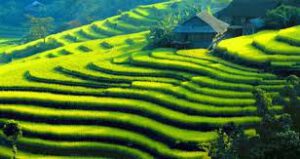
- Nam Ty Terraces
Location: Nam Ty Commune, Hoang Su Phi District, Ha Giang Province
Ethnic Minorities: La Chi
Long-Standing Tradition of Terrace Farming
Nam Ty’s terraces have been an integral part of the La Chi culture for generations. These terraces are characterized by their intricate patterns and sustainable farming methods.
Cultural Significance and Economic Importance
The terraces play a crucial role in the local economy, supporting the La Chi community through agriculture and tourism. Visitors can learn about the traditional practices that have sustained these terraces for centuries.
Visiting Tips
The ideal time to visit Nam Ty is during the harvest season when the terraces are lush and green. Bring water, snacks, and a sense of adventure to explore these remote yet stunning landscapes.
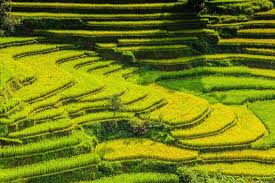
- Xin Man Terraces
Location: Xin Man District, Ha Giang Province
Ethnic Minorities: Nung, Tay, H’mong
Rich Agricultural History and Preserved Traditional Methods
Xin Man is known for its rich agricultural history and well-preserved traditional farming techniques. The terraces are a beautiful example of harmonious living with nature.
Local Food Security and Cultural Importance
The terraces are crucial for local food security, providing a stable food source and supporting the cultural practices of the Nung, Tay, and H’mong people.
Visiting Tips
The best time to visit Xin Man is late summer to early autumn. Ensure you have a local guide to navigate the area and learn about the history and techniques of terrace farming.
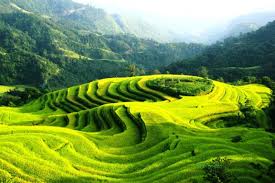
- Thien Huong Terraces
Location: Dong Van District, Ha Giang Province
Ethnic Minorities: Tay, Dao
Centuries-Old Farming Practices and Traditional Terracing
Thien Huong’s terraces are steeped in history, with traditional farming practices passed down through generations. These terraces are an essential part of the Tay and Dao communities’ livelihoods.
Local Legends and Stories
Local legends often speak of the ancestors who first carved these terraces the mountains, creating a sustainable way of life that continues to this day.
Visiting Tips
The best time to visit Thien Huong is during the growing season when the terraces are vibrant green. Respect the local customs and interact with the farmers to gain deeper insights their way of life.
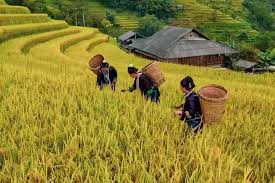
- Quang Ba Terraces
Location: Quan Ba District, Ha Giang Province
Ethnic Minorities: Dao, Tay, H’mong
Developed Over Generations and Traditional Farming Techniques
The terraces in Quang Ba have been developed over generations, reflecting the agricultural ingenuity of the Dao, Tay, and H’mong people. These terraces are a beautiful blend of nature and human effort.
Cultural Significance and Local Ingenuity
The terraces are not only a source of food but also a cultural heritage, showcasing the ingenuity and hard work of the local communities.
Visiting Tips
Visit during the planting season for the most picturesque views. Bring your camera to capture the stunning landscapes and interact with local guides to learn about the history and techniques of terrace farming.
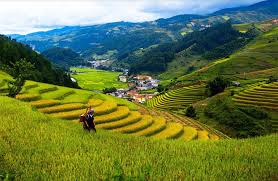
- Cultural Insights and Ethnic Minorities
Overview of Ethnic Minorities Involved in Terrace Farming
The Ha Giang Loop is home to several ethnic minorities, including the H’mong, Dao, Tay, and La Chi. Each group has unique traditions and practices that contribute to the rich cultural tapestry of the region.
Traditional Agricultural Practices and Cultural Significance
Terrace farming is a testament to the ingenuity and resilience of these communities. It supports their livelihoods and sustains their cultural traditions, ensuring the preservation of their heritage.
How Terrace Fields Support the Local Economy and Community
Terraces are crucial for local food production and tourism, providing a stable income for the communities and supporting local economies.
- Historical Background of Terrace Farming
History of Terrace Farming in Ha Giang Loop
Terrace farming in Ha Giang Loop dates back centuries, with techniques passed down through generations. The terraces are a symbol of sustainable agriculture and cultural heritage.
Development and Evolution Over the Centuries
The techniques have evolved over time, incorporating modern methods while preserving traditional practices. This blend of old and new ensures the sustainability of terrace farming.
Influence of Chinese and Southeast Asian Agricultural Techniques
Terrace farming techniques in Ha Giang have been influenced by Chinese and Southeast Asian agricultural practices, creating a unique and effective system that supports local communities.
- Tips for Visiting Terraces in Ha Giang Loop
Essential Items to Pack for Your Visit
- Comfortable walking shoes
- Sun protection (hat, sunscreen)
- Water and snacks
- Camera for capturing stunning views
Best Times of the Year to See the Fields in Their Prime
The best times to visit are during the planting season in May and the harvest season in September-October. During these periods, the terraces are at their most vibrant and picturesque.
How to Respect the Local Culture and Environment
Respect the local customs and traditions by engaging with the communities and learning about their practices. Follow Leave No Trace principles to preserve the natural beauty of the area.
Conclusion
The terraces of Ha Giang Loop are not just agricultural marvels but also cultural treasures that reflect the rich heritage and ingenuity of the local ethnic minorities. Exploring these terraces with NorthStar Tours offers a unique opportunity to connect with nature, learn about traditional farming practices, and immerse yourself in the local culture. Plan your visit to the stunning terraces of Ha Giang Loop today and experience the beauty and heritage of this remarkable region.

 +84 91 322 2269
+84 91 322 2269